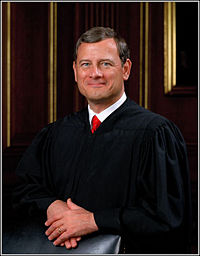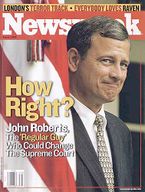John Roberts
 From Conservapedia
From Conservapedia | John G. Roberts, Jr. | |||
|---|---|---|---|
| |||
| Chief Justice of the U.S. Supreme Court From: September 29, 2005 – present | |||
| Nominator | George W. Bush | ||
| Predecessor | William Rehnquist | ||
| Successor | Incumbent (no successor) | ||
| Information | |||
| Spouse(s) | Jane Sullivan Roberts | ||
| Religion | Cafeteria Catholic | ||
John G. Roberts, Jr. (January 27, 1955) is the 17th and current Chief Justice of the U.S. Supreme Court, since 2005. He was appointed by President George W. Bush to replace William Rehnquist as Chief Justice, after having served on the Court of Appeals for the D.C. Circuit. Chief Justice Roberts provided the pivotal 5th vote to uphold ObamaCare on the unexpected grounds that he found it to be a tax, rather than a proper exercise of Commerce Clause authority, after suspiciously switching sides according to WikiLeaks.[1][2] Roberts is alleged to have illegally adopted two kids from Ireland.[3] The name "John Roberts" appeared on the Epstein Island flight logs in 2019.[4]
Roberts has not provided the 5th vote for the side opposed by the liberal media since 2013, when he held that pre-clearance for election law changes were archaic and unnecessary in Shelby County v. Holder.[5] Then that was not a very high-profile issue, and a year earlier Roberts avoided being the conservative 5th vote against ObamaCare.
Like the notorious Chief Justice John Marshall who pretended to oppose slavery while voting against slaves in every case, Chief Justice John Roberts pretends to oppose abortion while voting in the last few years for the pro-abortion side every single time, most recently in voting unsuccessfully to block a pro-life Texas law on September 1, 2021, in Whole Woman's Health et al. v. Austin Reeve Jackson, Judge (No. 21A24). Roberts weakly concurred in judgment to uphold the Mississippi abortion law in Dobbs v. Jackson Women's Health Organization, while siding with liberals in opposing the 5-4 overturning of Roe v. Wade.
Roberts does not adhere to judicial originalism and seeks to bend the law to not appear too "conservative."[6] On November 21, 2018, the Chief Justice Roberts issued an unusual rebuke of President Trump's reference to an "Obama judge," even though Trump's comments were supported by a statistical analysis of forum-shopping by the Left in their lawsuits against Trump, and the decisions in those cases. President Trump immediately responded with tweets criticizing the Chief Justice and pointing to the evidence.[7] However, Roberts did not issue such a statement after Obama criticized Supreme Court justice Samuel Alito for ruling in a way the former disapproved of.[8] Confirmed by the Senate based on his promise to act as a neutral "umpire", Roberts has been criticized by conservatives for doing the opposite.[9]
Contents
Early Years[edit]
Roberts was born in Buffalo, New York, on January 27, 1955.[10]
Judicial Philosophy[edit]
Chief Justice John Roberts is known best for building a consensus, and writing opinions to maximize support by fellow Justices. While other Justices often cite their own prior opinions, Chief Justice Roberts is a master at citing the decisions of fellow Justices to win their support for his opinion. But by emphasizing consensus rather than clarity and force of an opinion, Roberts can issue a weak 6-3 or 9-0 opinion rather than a stronger 5-4 version.[11]
| “ | If you watched the confirmation hearings for his nomination to be chief justice of the Supreme Court, you know why the Left hates him. Without notes, Roberts, a constructionist, schooled every single one of the Judiciary Committee’s far-Left senators on constitutional jurisprudence. Having someone of his intellect, worldview and legal understanding as chief justice does wonders to protect the Constitution from those who would amend it by judicial fiat. --- Town Hall Magazine [12] | ” |
However, in 2012, Justice Roberts showed he lacked firm convictions as far as being a constructionist by cowardly abdicating his responsibility as a Supreme Court judge in his unconstitutional upholding of ObamaCare.[13][14], which he called "Congress' right to tax", and that is the same as what was proposed in the 2010 Patient Protection and the Affordable Care Act.
Confirmation Process[edit]
With the death of Chief Justice William Rehnquist in 2005, President Bush withdrew Roberts' nomination for associate justice to replace Sandra Day O'Connor and renominated him for chief justice, with only a slight delay in his confirmation hearings to allow for Rehnquist's funeral services. The nomination was first considered by the 18-member Senate Judiciary Committee. On September 22, the committee voted 13–5 to send Roberts' confirmation to the full Senate, winning the support of Judiciary Committee Chairman Arlen Specter (R-Pennsylvania), and ranking minority member Patrick Leahy (D-Vermont). On September 29, Roberts was confirmed by the full Senate by a vote of 78–22. Hours after confirmation, he was sworn in by the senior associate justice, John Paul Stevens at the White House.
Right to Privacy[edit]
Until 1965, some US states criminalized the distribution of contraceptives. In 1965 the Supreme Court in Griswold v. Connecticut, ruled the laws unconstitutional because they violated the right of privacy. Roberts said he would uphold "Griswold" at his 2005 confirmation hearings to be Chief Justice if the case was brought before him, and indicated that he felt that the issue was closed.[15]
- When asked, "Do you agree that there is a right of privacy to be found in the liberty clause of the Fourteenth Amendment?" Roberts responded:
- "I do, Senator. I think that the court's expressions, and I think if my reading of the precedent is correct, I think every justice on the court believes that, to some extent or another. Liberty is not limited to freedom from physical restraint. It does cover areas, as you said, such as privacy. And it's not protected only in procedural terms but it is protected substantively as well."
- "I agree with the Griswold court's conclusion that marital privacy extends to contraception and availability of that. The court, since Griswold, has grounded the privacy right discussed in that case in the liberty interest protected under the due process clause."
- "I feel comfortable commenting on Griswold and the result in Griswold because that does not appear to me to be an area that is going to come before the court again."
United States Supreme Court[edit]
In his first two years on the U.S. Supreme Court, Chief Justice Roberts has written only 24 opinions, mostly on uncontroversial or simple topics. In his first year he sought unanimity in his decisions, leading him to dilute the strength of his opinions to satisfy everyone. For example, Chief Justice Roberts obtained unanimity on a controversial Solomon Amendment opinion by stretching to satisfy protesters against military recruiters:[16]
- The Solomon Amendment neither limits what law schools may say nor requires them to say anything. Law schools remain free under the statute to express whatever views they may have on the military's congressionally mandated employment policy, all the while retaining eligibility for federal funds. See Tr. of Oral Arg. 25 (Solicitor General acknowledging that law schools "could put signs on the bulletin board next to the door, they could engage in speech, they could help organize student protests"). As a general matter, the Solomon Amendment regulates conduct, not speech. It affects what law schools must do--afford equal access to military recruiters--not what they may or may not say.
Similarly, in the campaign finance case, Roberts invalidated the restriction at issue but avoided establishing a bright-line rule in favor of political free speech.[17]
Record as an Appellate Judge[edit]
Chief Justice John Roberts served only briefly as a judge on the Court of Appeals for the D.C. Circuit before being nominated and confirmed for the U.S. Supreme Court (he was originally nominated in 1992 for the Court of Appeals by the first President Bush, but the Senate controlled by the Democrats at the time did not allow a vote on his nomination). In one important dissent, then-Judge Roberts declared that "a facial challenge can succeed only if there are no circumstances in which the Act at issue can be applied without violating the" Constitution. Rancho Viejo, LLC v. Norton, 334 F.3d 1158, 1160 (D.C. Cir. 2003), cert. denied, 541 U.S. 1006 (2004).
Health Problems[edit]
Justice Roberts suffered a seizure on July 30, 2007 while at his vacation home in Port Clyde, Maine on Hupper Island. As a result of the seizure he fell five to ten feet but suffered only minor scrapes. The fall occurred on a dock near his house and he was taken by private boat to the mainland. Doctors called the incident a benign idiopathic seizure which means there was no obvious physiological cause. Roberts suffered a similar seizure in 1993.
See Also[edit]
References[edit]
- ↑ https://wikileaks.org/podesta-emails/emailid/3323
- ↑ http://www.dailywire.com/news/10175/wikileaks-hillary-ally-spoke-campaign-about-frank-camp
- ↑ https://www.americanthinker.com/articles/2014/02/the_ghost_and_john_roberts.html
- ↑ https://twitter.com/Inevitable_ET/status/1273636428287631360
- ↑ https://www.huffpost.com/entry/john-roberts-supreme-court-voter-suppression_n_60d4f7ffe4b0da66c2dd7e14
- ↑ Horowitz, Daniel (September 13, 2019). Why conservatives must fight judicial supremacism — and not hang their hopes on John Roberts. Conservative Review. Retrieved September 13, 2019.
- ↑ https://www.apnews.com/c4b34f9639e141069c08cf1e3deb6b84
- ↑ Multiple references:
- Pollak, Joel B. (November 21, 2018). Chuck Grassley to Chief Justice John Roberts: You Rebuked Trump — but Sat Silent Through Obama’s Abuse. Breitbart News. Retrieved November 22, 2018.
- Lim, Naomi (November 21, 2018). Chuck Grassley: I don’t recall Chief Justice John Roberts attacking Obama after he rebuked Alito. Washington Examiner. Retrieved November 21, 2018.
- DiGenova, Joseph (November 21, 2018). Justice Roberts’ attack against President Trump was blatantly political and wrong. Fox News. Retrieved November 22, 2018.
- ↑ Hillyer, Quin (February 5, 2019). John Roberts biography still leaves Obamacare case as a travesty. Washington Examiner. Retrieved February 5, 2019.
- ↑ Biographies of Current Justices of the Supreme Court
- ↑ See, e.g., Medellin v. Texas (2008).
- ↑ Town Hall Magazine; The 100 Americans The Left Hates Most
- ↑ Roberts the Coward - NY Post
- ↑ The Real Reason John Roberts Upheld ObamaCare? By Selwyn Duke
- ↑ See quotations
- ↑ 126 S. Ct. 1297, 1307 (2006).
- ↑ FEC v. Wis. Right to Life, Inc., 127 S. Ct. 2652 (2007).
| The U.S. Supreme Court | ||||||||
|---|---|---|---|---|---|---|---|---|
| Chief Justice John Roberts's Court (2005-Present) | ||||||||
|
Categories: [United States Supreme Court Justices] [United States Chief Justices] [Liberal Deceit] [Abortion Advocates] [Moderates] [Establishment] [Republican Establishment]
↧ Download as ZWI file | Last modified: 03/15/2023 17:31:37 | 20 views
☰ Source: https://www.conservapedia.com/John_Roberts | License: CC BY-SA 3.0
 ZWI signed:
ZWI signed:

 KSF
KSF